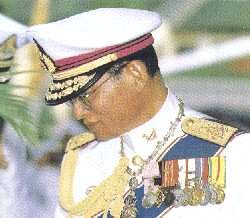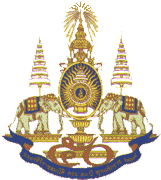 Hornbill (¹¡à˧×Í¡)
Hornbill (¹¡à˧×Í¡)
List and Rare of Hornbills in Thailand
Hornbills in Thailand Slide Show
Bibliography to hornbills of Thailand
World Hornbill Network


|
- His Majesty King Bhumibol Adulyadaj ascended to the throne on June 9, 1946 and is already listed in the Guinness Book of Records 1996
as the world's longest-reigning monarch.
- Now, His Majesty has set a new record in the Guinness Book of Records 1998 -- as the holder of more honorary academic degrees than anyone else in the world.
The King has received a grand total of 136, comfortably exceeding the 131 awarded to Father Theodore Hesburgh, president of Notre Dame University in the United States.
- The longest current reigning monarch in the world.
- King Bhumibol Adulyadaj, the ninth monarch of the Chakri dynasty of Thailand, is currently the world's longest reigning monarch, having succeeded to the throne on June 9, 1946. The reign is both an historic milestone and a personal triumph.
It stands as a remarkable testament to the role of the monarchy which has guided the nation for more than 700 years since its birth in the 13th century. But not only has King Bhumibol Adulyadaj preserved the continuity of a regal tradition in Thailand,
he has also succeeded in enhancing its relevance in an age when royalty elsewhere has either vanished or become irrelevant and anachronistic.
- The key to that success has been stability which the monarchy has helped to provide during decades of accelerated political and socio-economic change. During this period of rapid advancement King Bhumibol has reigned.
Remarkably he was not trained for the role from birth as were most of his illustrious predecessors, and the way in which he rapidly adapted to, and more significantly, interpreted his unexpected succession to the throne is a measure of his great achievement.
- Thailand is now a constitutional monarchy though its particular form is unique and defies comparison with, for example, the United Kingdom. Although absolute powers were dissolved in 1932, the role of the King has not been reduced to a figurehead.
For some understanding of this rare state of affairs, of the nature of the Thai monarchy with its blend of semi divine status and strong paternalism -- dual elements that trigger enormous devotion and deep respect among the common people -- it is necessary to take a glance at the country's historical development.
- There is an almost mystical bond between Thais and their monarchy which transcends, for example, the affection the British have for Queen Elizabeth II or even the Queen Mother. Portraits of Their Majesties are found in virtually every home, office, shop and public building in the land,
and the royal family draws huge crowds, whether at a state ceremony in Bangkok, or on a tour of some distant farming community.
- While political power lies with the constitution and the King is above fractious multi-party politics, his presence does have a stabilizing effect. In 1973, for example, when students and then military government clashed, His Majesty was instrumental in helping to defuse the tention.
In a rare interview, King Bhumibol told British journalist David Lomax that he saw his duty as trying to "keep a middle, peaceful and neutral co-existence with all the pressure groups in the country. If you have in a country political parties which all have their own interests at heart, what about those who don't have power?
Ordinary people who cannot make their views known must look up to someone who is impartial."
- The King, with his introspective and compassionate air, is a devout Buddhist and, like all Thai kings, spent a period in monkhood. He is well versed in science and technology, and speaks several European languages. His other accomplishments -- playing jazz, painting and photography -- have been mostly laid aside so that he can devote more time to his people's welfare.
- When he ascended the throne he faced a difficult task. The monarchy had been shaken by two reigns ending unexpectedly. Political and economic problems shortly became manifest, especially growing communist insurgency in the depressed northeast region. Seemingly undaunted,
King Bhumibol set himself to fulfil tradition and the ancient cononation pledge that, "We will reign with righteousness, for the benefits and happiness of the Siamese people."
- How he was to interpret his role was first made apparent in 1955 when, ccompanied by Her Majesty Queen Sirikit, he made a 22-day tour of northeast Thailand, the most neglected area of the country. The people, most of whom had never seen a Thai king in person before, flocked to pay homage.
- This pioneering tour was to set the pattern for the reign. Every year the King spends seven to eight months outside Bangkok touring all parts of the country. His annual journeys by limousine, land rover and helicopter cover some 50,000 kilometres, many of them over rugged hill country and through remote rural districts. He has visited all 76 provinces, most several times, and has been seen in person by more of his people than any other Thai monarch.
- These provincial tours, usually made in the company of the Queen and one or more of the royal children, are frequently of an imformality unseen among other monarchies. Their Majesties are approached by villagers who want to discuss their problems, as well as express their devotion. But this is no mere exercise in public relations. The tours serve practical ends.
Characteristically, the King is seen on his visits clutching a large-scale map, and addressing problems first hand. Using his knowledge of science and technology, he organizes and oversees development projects.
- Since more than 75 per cent of the population lives off the land, most of these projects are related to agricultural improvement. More than 1,500 have been instigated to date, and range from fish-farming to artificial rain-making, from reservoirs to crop substitution programmes for the opuim-growing hilltribes of the north.
In scope they vary from inexpensive community development to a multi-million-dollar irrigation scheme.
- The benefits are extensive, in direct and indirect terms. Communist insurgency in the Northeast, for example, was once rampant but has now disintegrated largely because Their Majesties have not ignored people's problem.
- The commitment to national welfare is complete. To give but one instance, Chitralada Palace, the royal residence in Bangkok, is far removed from the fantasy world of some Hollywood director. Any preconceptions you may have from the King and I musical and movie are shattered by the knowledge that in the palace grounds is an experimental farm for dairy cattle and the testing of new strains of rice seed.
- This is modern Thai kingship and His Majesty has a full official calendar. And one of his series of engagements, in particular, shows his commitment to contact with his subjects: every year at university graduation ceremonies, His Majesty personally hands students their diplomas.
- At the same time, much of the ancient royal ceremonail survives. Numerous events, such as the Annual Ploughing Ceremony, a rite to ensure a good harvest, and the thrice-yearly changing of the robes of the Emerrald Buddha, the nation's most sacred image, are glorious affairs full of pageantry, serving to preseve vital links with the past and to exemplify the continuting symbolic role of monarchy.
- King Bhumibol magnificently personifies the concept of regal continuity, which preserves national heritage, while also demonstrating modern constitutional monarchy at its finest, addressing itself to current needs and concerns. In celebrating His Majesty's reign as the longest in World history. It is fitting to acknowledge how it wonderfully reaches to link the strengths of the past with the hopes and aspirations of today

|
|
Return to the Top or
|
|
|





